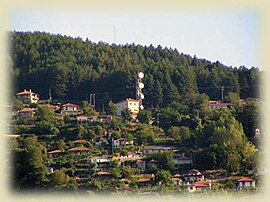| Revision as of 09:14, 10 June 2024 editOnel5969 (talk | contribs)Autopatrolled, Extended confirmed users, Page movers, New page reviewers, Pending changes reviewers, Rollbackers939,360 editsm Disambiguating links to Central Greece (link changed to Central Greece (administrative region)) using DisamAssist.← Previous edit |
Latest revision as of 04:51, 27 October 2024 edit undoMonkbot (talk | contribs)Bots3,695,952 editsm Task 20: replace {lang-??} templates with {langx|??} ‹See Tfd› (Replaced 1);Tag: AWB |
| Line 20: |
Line 20: |
|
|caption_skyline = |
|
|caption_skyline = |
|
}} |
|
}} |
|
'''Granitsa''' ({{lang-el|Γρανίτσα}} from the ] word for "border") is a mountain village and a community in ], ]. It is situated at 720 meters elevation, on a mountain slope above the river ]. It is built in the forested lower regions of ]. Granitsa was the seat of the municipality of ]. The community consists of the villages Granitsa, Ano Potamia, Kato Potamia and Armampela. The village preserves its old appearance. It is 82 kilometers northwest of ]. |
|
'''Granitsa''' ({{langx|el|Γρανίτσα}} from the ] word for "border") is a mountain village and a community in ], ]. It is situated at 720 meters elevation, on a mountain slope above the river ]. It is built in the forested lower regions of ]. Granitsa was the seat of the municipality of ]. The community consists of the villages Granitsa, Ano Potamia, Kato Potamia and Armampela. The village preserves its old appearance. It is 82 kilometers northwest of ]. |
|
|
|
|
|
Granitsa is the birthplace of artists such as ], ], and ]. It is also the home of ], who became a martyr after he was killed in 1544. Granitsa had seventeen churches, most of which were destroyed during ] rule. It has a Folklore Museum which contains popular art such as woven objects, carved wooden objects, rural cattle-raising tools, a loom, local clothes and weapons from the ]. The museum also contains portraits and personal belongings of individuals such as ] and Stefanos Granitsas, paintings of the popular local painters Christos Kagaras and ] and the personal book collection of Zacharias Papantoniou. Other notable sights are the remaining nine churches of the village. |
|
Granitsa is the birthplace of artists such as ], ], and ]. It is also the home of ], who became a martyr after he was killed in 1544. Granitsa had seventeen churches, most of which were destroyed during ] rule. It has a Folklore Museum which contains popular art such as woven objects, carved wooden objects, rural cattle-raising tools, a loom, local clothes and weapons from the ]. The museum also contains portraits and personal belongings of individuals such as ] and Stefanos Granitsas, paintings of the popular local painters Christos Kagaras and ] and the personal book collection of Zacharias Papantoniou. Other notable sights are the remaining nine churches of the village. |


